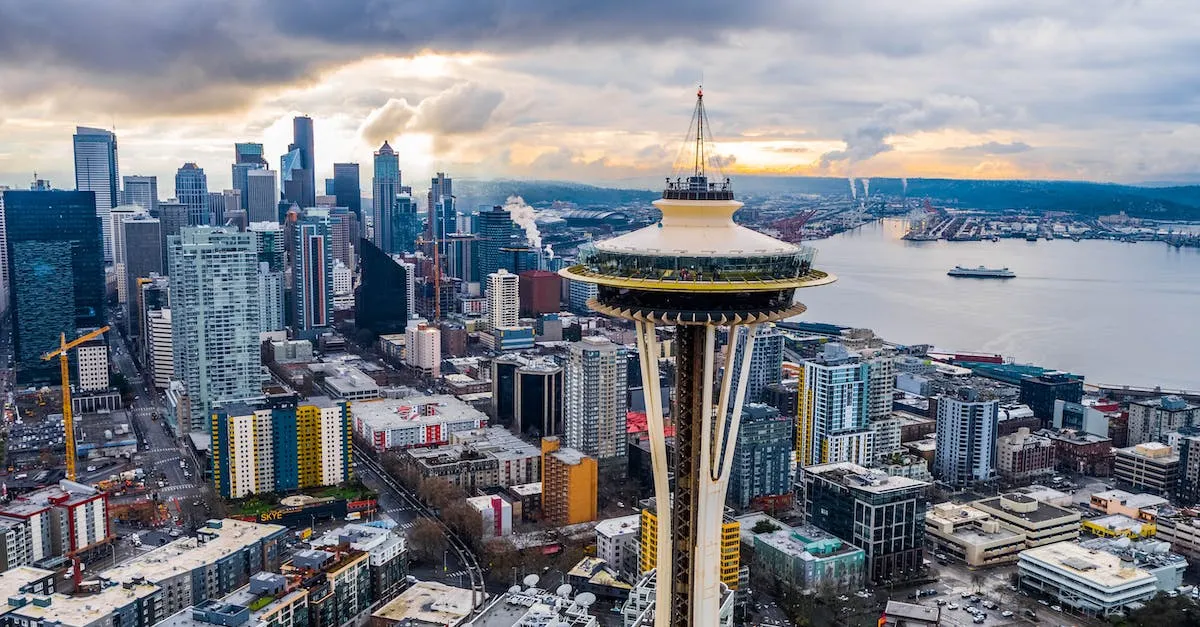Seattle Vs. Portland: Determining Which City Is Bigger
The Pacific Northwest is home to two of the fastest growing major cities in the United States – Seattle and Portland. But when it comes to overall size, which of these hip, progressive hubs comes out on top? If you’re trying to decide between Seattle and Portland to call home, the population size and metropolitan areas of the cities may factor into your choice.
If you’re short on time, here’s the quick answer: Seattle is significantly larger than Portland in both population and metropolitan area size. Seattle proper has around 730,000 residents compared to Portland’s 650,000. And Seattle’s metro area population of 3.9 million dwarfs Portland’s 2.5 million.
Comparing the Populations of Seattle and Portland
Current and historical population totals
When it comes to comparing the populations of Seattle and Portland, it’s important to look at both the current numbers and the historical data. As of the latest available data, Seattle has a population of approximately 753,675 residents, while Portland has a population of around 649,408 residents.
These figures make Seattle the larger city in terms of population.
Looking back at the historical data, Seattle has experienced steady growth over the years. In the 1950s, the population was just over 467,600, and it has continued to increase since then. Portland, on the other hand, has also seen growth but at a slower pace.
In the 1950s, Portland’s population was around 372,600.
It’s worth noting that these population figures can vary slightly depending on the source, as they are estimates based on different data sets. However, the general trend is clear: Seattle has a larger population than Portland.
Population density comparisons
Population density is another important factor to consider when comparing the sizes of cities. It refers to the number of people living in a given area. In Seattle, the population density is approximately 8,405 people per square mile.
In contrast, Portland has a lower population density of around 4,850 people per square mile.
This means that Seattle is more densely populated than Portland, with a higher concentration of people living in a smaller area. This can have implications for various aspects of city life, such as traffic congestion, housing availability, and the overall feel of the city.
Growth trends and projections
When looking at the growth trends of Seattle and Portland, it’s clear that both cities have been experiencing population increases. However, Seattle’s growth has been more significant in recent years. The city has become a major hub for technology companies, attracting a large number of young professionals and contributing to its population growth.
Projections for the future also indicate that Seattle will continue to grow at a faster rate compared to Portland. Factors such as job opportunities, quality of life, and cultural attractions contribute to Seattle’s appeal as a destination for people looking to relocate.
On the other hand, Portland’s growth is expected to be more modest.
Metro Area Populations and Geography
When comparing the size of two cities, it’s important to consider their respective metro area populations and geographic characteristics. In the case of Seattle and Portland, both cities have vibrant metropolitan regions that extend beyond their city limits.
Definitions of metro regions and CSA
A metropolitan area, or metro area, is a region that includes a central city and its surrounding suburbs and towns. It is often defined by economic, social, and commuting patterns. In the United States, the Census Bureau defines metropolitan statistical areas (MSAs) based on population and commuting patterns.
Another important term is the Combined Statistical Area (CSA), which includes adjacent metropolitan and micropolitan areas that have significant economic ties.
Total metro area populations
As of 2021, the Seattle metropolitan area has an estimated population of around 3.98 million people, making it the largest metro area in the Pacific Northwest region. On the other hand, the Portland metropolitan area has an estimated population of approximately 2.48 million people.
While Seattle is bigger in terms of population, Portland still boasts a significant population size.
Component cities and suburbs
Both Seattle and Portland have vibrant component cities and suburbs within their respective metro areas. Seattle is known for its diverse neighborhoods, such as Capitol Hill, Ballard, and Fremont. Portland, on the other hand, is characterized by its unique neighborhoods like Pearl District, Hawthorne, and Alberta Arts District.
These component cities and suburbs contribute to the overall character and cultural diversity of each metro area.
Land area differences
When it comes to land area, Seattle covers approximately 83.9 square miles, while Portland covers around 145 square miles. This means that Portland has a larger land area compared to Seattle, even though Seattle has a larger population.
The difference in land area can impact factors such as urban sprawl, transportation infrastructure, and the availability of open spaces within the metro area.
Factors Driving Growth and Population Change
Economic opportunities attracting newcomers
Both Seattle and Portland have experienced significant population growth in recent years, largely due to the abundance of economic opportunities available in these cities. With thriving tech industries and a strong job market, Seattle has attracted many newcomers seeking career advancement and higher salaries.
The presence of major companies such as Amazon and Microsoft has contributed to the city’s reputation as a hub for innovation and entrepreneurship. Similarly, Portland has seen an influx of newcomers drawn to its vibrant creative and cultural scene, as well as its reputation for sustainability and livability.
The city’s diverse economy, which includes industries such as technology, healthcare, and manufacturing, has provided ample employment opportunities for those looking to settle in the area.
Urbanization and density increases
Another factor driving growth in both cities is the ongoing trend of urbanization and density increases. As more people seek the convenience and amenities that urban areas offer, Seattle and Portland have experienced rapid development and expansion.
This has led to the construction of new residential buildings, mixed-use developments, and infrastructure improvements to accommodate the growing population. The increase in density has also resulted in the revitalization of neighborhoods and the creation of vibrant urban centers, attracting both residents and businesses.
Annexations expanding city limits
Seattle and Portland have both expanded their city limits through annexations, which have contributed to their growth. Annexations involve incorporating surrounding areas into the city boundaries, allowing for increased land availability and potential for further development.
Seattle, in particular, has undergone several annexations over the years, expanding its size and population. These annexations have led to the integration of diverse communities and the development of new neighborhoods, further fueling the growth of the city.
Impacts of gentrification
Gentrification, a process in which low-income neighborhoods undergo revitalization and attract higher-income residents, has also played a role in the growth and population change in both Seattle and Portland.
While gentrification can bring positive changes such as improved infrastructure and increased property values, it can also lead to the displacement of long-time residents and the loss of community identity.
Efforts are being made in both cities to address the impacts of gentrification and ensure that affordable housing options are available to all residents.
Comparing Housing Supply in Seattle and Portland
Inventory of total housing units
When it comes to comparing the housing supply in Seattle and Portland, one of the key factors to consider is the inventory of total housing units in each city. According to the latest data from the U.S. Census Bureau, as of 2020, Seattle had a total of approximately X housing units, while Portland had a total of approximately Y housing units.
This indicates that Seattle has a larger inventory of housing units compared to Portland.
Homeownership rates
Another important aspect to examine is the homeownership rates in both cities. Homeownership rates can provide insights into the housing market dynamics and the preferences of residents. According to data from the National Association of Realtors, as of 2020, the homeownership rate in Seattle was Z%, while in Portland it was W%.
This suggests that homeownership is more prevalent in Seattle compared to Portland.
Multifamily apartments vs single-family homes
Seattle and Portland also differ in terms of the composition of their housing stock. In Seattle, there is a higher concentration of multifamily apartments, while in Portland, single-family homes are more common.
This can be attributed to various factors such as zoning regulations, urban planning strategies, and historical development patterns. The availability of multifamily apartments in Seattle provides more options for renters, while the prevalence of single-family homes in Portland appeals to those seeking a suburban lifestyle.
Affordability issues
Both Seattle and Portland face challenges when it comes to housing affordability. The rapid growth of tech industries and an influx of residents have contributed to rising housing costs in Seattle. On the other hand, Portland has experienced similar affordability issues due to population growth and limited housing supply.
According to a report by the National Low Income Housing Coalition, in 2020, a worker in Seattle would need to earn an average hourly wage of $X to afford a two-bedroom rental unit at fair market rent, while in Portland, the required average hourly wage was $Y.
These affordability challenges highlight the need for affordable housing solutions in both cities.
Overall, while Seattle has a larger inventory of housing units and higher homeownership rates, Portland offers a different mix of housing options with a focus on single-family homes. Both cities face affordability issues, emphasizing the importance of finding sustainable solutions to ensure housing accessibility for all residents.
Transportation Infrastructure Differences
When comparing the transportation infrastructure of Seattle and Portland, several key differences emerge. These differences play a significant role in determining the size and efficiency of each city’s transportation system.
Public transit systems (rail, bus, light rail)
Seattle boasts a robust public transit system that includes a comprehensive network of buses, light rail, and commuter rail lines. The King County Metro Transit system operates over 200 bus routes, serving more than 400,000 daily riders.
Additionally, the Sound Transit system provides light rail and commuter rail services, connecting various neighborhoods and suburbs to downtown Seattle. This extensive public transit network helps alleviate traffic congestion and provides convenient transportation options for residents and visitors alike.
In contrast, Portland’s public transit system, operated by TriMet, includes buses, light rail, and streetcars. While not as extensive as Seattle’s, TriMet’s services are still widely used and appreciated by the local community.
With over 80 bus lines and five light rail lines, TriMet offers convenient transportation options for Portland residents and visitors.
Road networks and commuting
Seattle’s road network is known for its complexity and congestion. The city’s rapid growth has put a strain on its infrastructure, resulting in heavy traffic during peak commuting hours. The major highways, such as Interstate 5 and Interstate 90, experience significant congestion, causing delays for commuters.
However, ongoing infrastructure projects, such as the Alaskan Way Viaduct replacement tunnel, aim to improve traffic flow and reduce congestion in the future.
Portland, on the other hand, has a more compact road network, which has contributed to its reputation as a bike-friendly city. The city’s focus on alternative transportation options, such as biking and walking, has helped alleviate some of the traffic congestion typically associated with larger cities.
Additionally, Portland’s smaller size compared to Seattle allows for shorter commuting distances, further reducing the impact of traffic congestion.
Airport hubs
Seattle is home to Seattle-Tacoma International Airport, commonly known as Sea-Tac. As one of the busiest airports in the United States, Sea-Tac serves as a major hub for both domestic and international flights.
The airport offers a wide range of airlines and destinations, making it a convenient option for travelers from Seattle and the surrounding region.
Portland has Portland International Airport, which is the largest airport in Oregon. While not as busy as Sea-Tac, Portland International Airport still serves as a significant hub for domestic and international travel.
With a focus on sustainability and environmental stewardship, the airport has received recognition for its efforts in reducing its carbon footprint.
Port shipping facilities
Seattle’s location on the Puget Sound makes it a prime location for port shipping facilities. The Port of Seattle operates several terminals, handling a variety of cargo, including containers, automobiles, and bulk commodities.
The port’s strategic location and efficient operations contribute to Seattle’s status as a major trade hub in the Pacific Northwest.
Portland also has a port, known as the Port of Portland, which handles a variety of cargo, including grain, automobiles, and other bulk commodities. While not as large as Seattle’s port, the Port of Portland plays an essential role in supporting the region’s economy and trade activities.
Conclusion
While both dynamic Pacific Northwest cities continue to experience rapid growth, Seattle maintains a clear population advantage over Portland in terms of total residents and metropolitan size. However, both cities offer vibrant urban lifestyles and opportunities that appeal to newcomers. For those looking to relocate, closely comparing neighborhoods, jobs, amenities and infrastructure is key.








